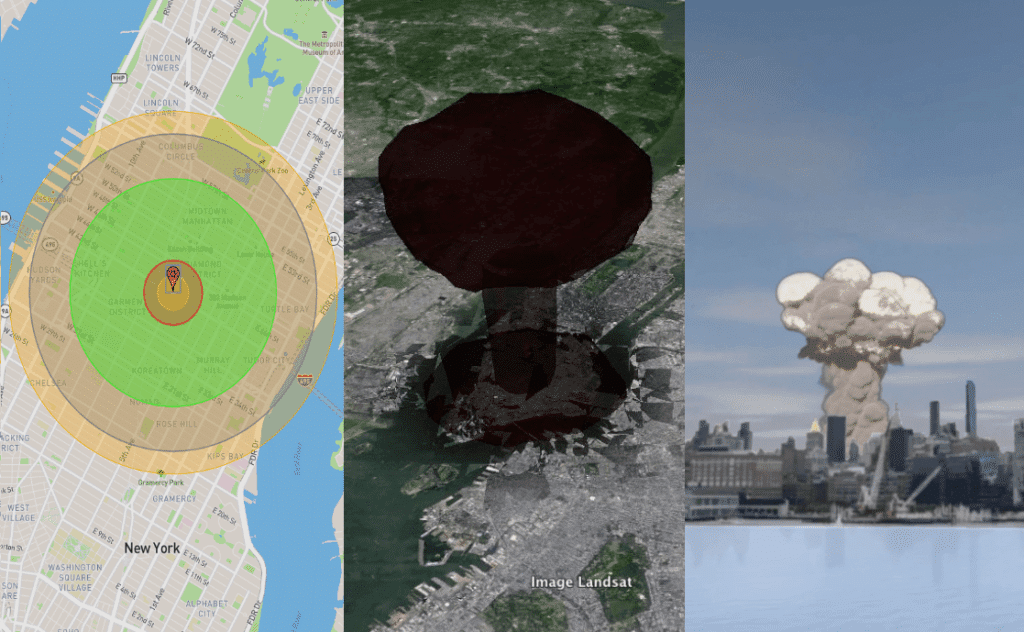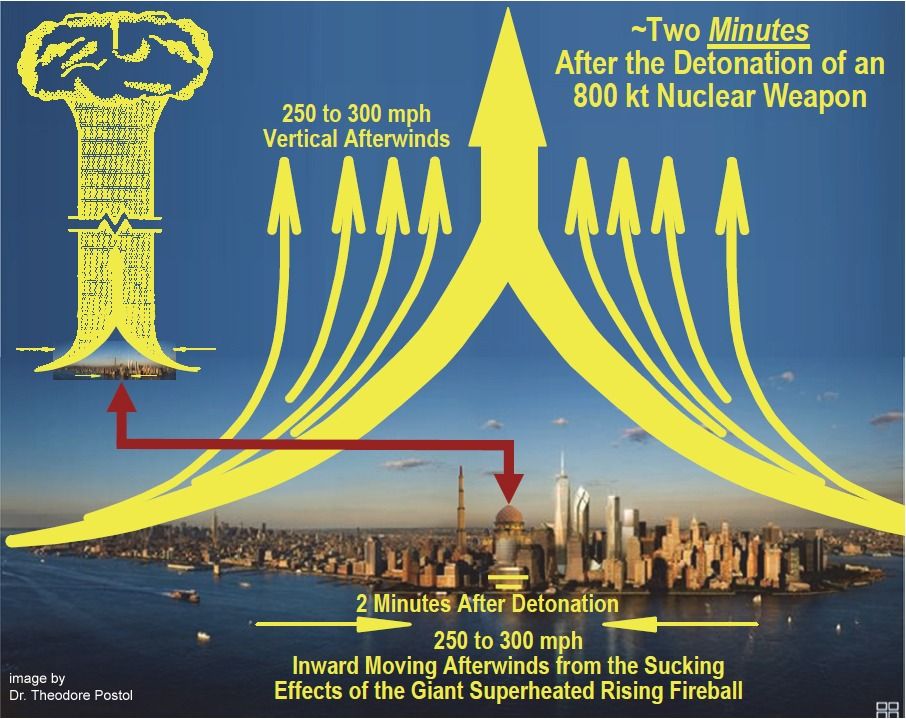Interview with Alex Wellerstein on NUKEMAP VR
By Alex Wellerstein, John Krzyzaniak | September 16, 2019
 Screenshots showing the two-dimensional, three-dimensional, and virtual reality versions of NUKEMAP.
Screenshots showing the two-dimensional, three-dimensional, and virtual reality versions of NUKEMAP.
It is no exaggeration to claim that, since it first went online in 2012, Alex Wellerstein’s original NUKEMAP tool has enabled millions of people all over the world to fathom the effects of a nuclear explosion. Now, together with fellow collaborators at the Stevens Institute of Technology, Wellerstein is working on a new project that combines the information base of NUKEMAP with the immersive first-person experience of virtual reality (VR). In this interview, Wellerstein discusses the first prototype of NUKEMAP VR, the possibilities it unlocks, and the feedback he has received so far.
John Krzyzaniak: What is NUKEMAP VR?
Alex Wellerstein: NUKEMAP VR is a collaboration between me and my colleague, Christopher Manzione, who is a virtual reality artist. Our aim is to translate some of the goals and even code of the NUKEMAP project into a virtual reality experience, in order to help people visualize and personalize the effects of a nuclear weapon.
It’s also an experiment to see whether or not this approach changes how people think about nuclear weapons. We have found that different types of representations of nuclear weapons can really change how people think of them. The effects of nuclear weapons are pretty hard for most people to conceptualize in their day-to-day life—for good reasons!
JK: Where did the idea come from?
AW: I’ve been thinking about representing nuclear weapons in virtual reality for a while. It feels a bit like a natural evolution of my other nuclear visualization work. And so when we were initially thinking about the Reinventing Civil Defense project, we asked ourselves what kinds of projects would we want to build that would not only be cutting edge, but might also be able to give us data about how you could influence how people think about nuclear weapons. This was one of the first ideas that came to my mind. Obviously there is a novelty in VR at the moment, so that automatically means that whatever we end up with, it’ll generate some attention and further thoughts.
The fact that we already had a lot of code for how to visualize the nuclear weapon made it easier. I had a version of NUKEMAP called NUKEMAP 3D for some time before Google ended its support for the API that it required to function, and that means I already had code for the mushroom cloud effects. I don’t do VR work myself, but I knew that Chris really was experienced and talented with it, and so it felt like a project that was ready to launch.
JK: If I were to try out NUKEMAP VR today, what would I see?
A video preview of NUKEMAP VR, courtesy of Christopher Manzione.
AW: It’s a VR application, so you have to put on a full 3D headset, and there’s the controller that you use to manipulate it. But it’s a fully immersive 3D experience.
Currently it is set from a single vantage point. You can move around and look around a little bit, but you’re basically limited to being in Hoboken at the Stevens Institute of Technology at our Babbio Center, which has a very nice view of the Manhattan skyline. And you’re looking at Manhattan, across the Hudson River, with the midtown to downtown skyscrapers filling the horizon.
In front of you there’s a console with a button on it—a big, red, stereotypical button that people associate with “the bomb.” To the left of the console, there is a screen that shows you various parts of the Little Boy bomb. There is also a scale model of the bomb next to you so you can get a sense for the size of it. It’s a fairly large weapon, physically.
There’s also a screen to the right of the console with an overhead map of the city, to give you another view of what you’re doing, at an isometric angle, sort of a helicopter’s view.
When you push the red button, you first get a blinding flash. Everything just goes totally white. A few seconds later, you hear the sound of the explosion, and then the whiteness fades away and you start to see this mushroom cloud pulling up above you in the skyline.
And the console on your right, the one that shows you the helicopter’s view of the city, displays the affected areas as you watch this cloud unfold. And the cloud takes some time to reach its maximum height. It’s a very tall cloud. At its maximum height it dwarfs the skyscrapers.
So that’s the experience as it exists at the moment. And you can hit reset and magically everything will be fixed, very much unlike how it works in the real world.
This is what one might call the “minimum viable product” version. It is not the final version, and it doesn’t do everything we imagine it might. When building such a complicated, multi-part application like this, it’s important to get something that you can start thinking with, that gives you ideas for future iterations, but proves that your basic idea was plausible.
So immediately after you use it, you think, okay, what if we had different types of bombs to model? What if we made the smoke look different? What if we also simulated fire effects? Could we make the arrival of the blast wave more impactful? What if we also gave an idea of casualties? There are a million other things you could add into it. But you have to get the baseline in place. Once you have that, often building out those additional parts is not as difficult.
JK: Who have you showed it to, and what has the feedback been?
AW: We unveiled it a few weeks ago at a showcase for products that we had funded under the Reinventing Civil Defense project. There were a fair number of academics, but also some artists, some members of the general public, and a few journalists. Interestingly, there was a Japanese news station that was extremely interested in this particular project. They were very interested in this sort of re-simulating of the bomb.
One provocative question they asked me was, “Do you think people who were victims of the Hiroshima bomb would be offended by this sort of gamification or simulation of that experience?” And my answer was essentially, “Well, I hope not.” But at the same time, the VR application is never going to replicate the true experience completely. Even the brightness of a nuclear weapon—you’re not allowed to blind people with your VR apps, even if the VR screens could technically do it. But I think that if you can give even a tiny sliver of that experience to people, it might shape their views on nuclear weapons in particular ways that would ideally lead them to think that they should not be used ever again. I would like to think that the Hiroshima victims would be supportive of that, if that was true. But again, at this stage it’s still an experiment.
Overall, though, the feedback has been pretty positive. Some people said that it did help them think about the bomb differently. My own interest in this sort of three-dimensional visualization came from the fact that even for me, someone who has studied these weapons for some time now, it was shocking to see how large the mushroom clouds of even “small” nuclear weapons were. It puts nuclear weapons into a new perspective, even if you already know a lot about them, but especially if you don’t.
What we’d really like to do next is develop it a little further and then actually do some really structured feedback surveys to measure peoples’ emotional and intellectual responses. We would like to know how the VR app affects how people perceive the experience as opposed to, say, the regular, original NUKEMAP, which is in 2D. It’s a very different way of perceiving the size of the weapon and the effects of the weapon.
Again, this is an experiment to see how valuable this more immersive technology is. Obviously it doesn’t do the same things as the web application. It’s a different kind of engagement. What do you gain, and what do you lose, when you change the form of media?
JK: Currently NUKEMAP VR simulates the explosion of the weapon used in the Hiroshima bombing, which had a yield equal to 15 kilotons of TNT. We know several countries today possess weapons that would produce a much larger explosion, even tens or hundreds of times larger. So why not simulate something bigger?
AW: The Hiroshima bomb is an interesting one to pick, both because it’s the first one, and because it’s how a lot of people engage with nuclear issues—through a historical lens.
Since a lot of people know it’s the first one, if you can impress them with that, then they say, “Oh my God, what would a modern one be like?” So it’s a nice gateway into thinking.
The size of the Hiroshima bomb is also an advantage. In terms of the human cost and damage to infrastructure, it is quite powerful of course. But it is not inconceivably powerful. One of the things we found in our research is that if you show people the biggest, most powerful thing there is, their response to that is sort of a numbing, because it’s hard to engage with. The biggest Cold War bomb might be a hundred megatons, right? And there’s nothing VR to see about that, at least from Hoboken. You’d be inside the fireball. You wouldn’t see anything. You’re too close.
And even from a far distance it would be so large that it would be hard to make sense of. Perhaps you could show what the mushroom cloud would look like if it went off in New York and you were observing it from Washington, D.C., if the weather were clear. But even that would be difficult to wrap your brain around. There’d be nothing human-sized to compare it to, because it’s larger than Mount Everest.
I often illustrate the scale of the mushroom clouds for people by using the Manhattan skyline as a reference. I like to point to the Freedom Tower, the new World Trade Center building, which is a massive building, much bigger than anything else on the New York City skyline, and you can really feel that when you’re looking at it from below. And I say, “Now for the Hiroshima bomb, which again was the first bomb, not even the most impressive, the maximum size of that mushroom cloud is about 11 times the height of that building. So stack 11 of those in your mind up there and look at how large that is.” And it makes you feel pretty small. So that’s the initial reason for using Hiroshima as the first reference.
The other reason is that you could justify it on the grounds that a terrorist nuclear weapon would be more like the Hiroshima bomb than a lot of the modern ones. But yeah, we’d like to offer some other options as well, eventually.
JK: Do you have a timeline for subsequent versions?
AW: We’re going to be working on this over the course of the next few months and seeing what changes we can make. Then we would like to run some rounds of testing on it.
One question you could ask is: Is the Hiroshima bomb more or less effective at eliciting a response than another yield? And you could make one version that was just the Hiroshima bomb, one version that was just the modern Trident nuclear warhead, and one version where subjects get to pick. And then you could find out how that choice changes their perceptions of it.
We’d like to do that kind of experimenting first before we put it out in the world, not only to debug and to make it as good as we can make it, but also because one can imagine adverse reactions. What if the VR experience made people excited about using nuclear weapons, or made them think they were no big deal? Maybe that wouldn’t be something we want to put out in the world without some refinement. I don’t think that’s the case, but we want to be cautious.
This is what I mean by it being a genuine experiment. It’s new territory and we’re really interested in finding out what kind of changes might get you different kinds of results. What if your perspective is not as a person standing on the ground, but seeing it from a helicopter? What if you’re at a different location? What if it was at night, as opposed to the day? Do these kinds of changes matter? That would be nice to find out.
In terms of future versions, in the next few years it will probably be possible to generalize this and have the vantage point be pretty much anywhere, rather than limiting it to Hoboken. Google has developed a VR Google Earth API, where in principle you could do this kind of thing in any city. Unfortunately, they haven’t made that available to us. We’ve asked them, and they basically told us that they’re only making the pilot version available to people making video games for the moment. I find that a little bit frustrating, but eventually I imagine that they will realize that it has more potential than that.
Related: What would happen if an 800-kiloton nuclear warhead detonated above midtown Manhattan?
JK: If and when you release it to the general public, would it be possible to view it on a computer monitor, or would a user need the VR equipment?
AW: In principle, anything we develop could be targeted for a computer monitor. But you would lose the true 3D aspect of it. It would be 2D on the computer, and not fill the user’s entire field of vision.
The tricky part about trying it on a computer is that it can be extremely nonintuitive to navigate a 3D world on the 2D environment of a computer monitor. It’s not impossible; people who play a lot of video games can do aspects of it straightforwardly. But it adds an additional layer of complication that makes it a little bit harder for most people to deal with. That was one of the difficulties with NUKEMAP 3D.
And the screen is not immersive in the same way. Although you can see some of the contrast and sizes, it’s not a full wraparound. You can’t turn your head and look behind you and get some sense of a dimensionality of it.
In the same sense, I’ve found that there’s a real difference between seeing rings on a map, like on the regular NUKEMAP, and seeing a volumetric mushroom cloud that towers over a skyline, like on NUKEMAP 3D. There is something that changes there in how your brain makes sense of it. You go from thinking the Hiroshima bomb was a little bomb to thinking, “Oh my God, that’s such a huge bomb. What would an even bigger one do?” That’s a psychological change, and that’s exactly the kind of thing my colleagues and I are interested in probing with this project.
JK: Have you heard from any governments about NUKEMAP VR?
AW: Not yet, but it’s very new. I have talked with government employees about the 2D NUKEMAP, though, and they are generally positive about it.
I’ve even been told by someone who worked in a missile silo that when they want to “play” around with the implications of nuclear weapons, they usually use NUKEMAP. They say that if they were to use government software, that would feel wrong, which I find both flattering and a little weird.
The only sort of critical concerns I’ve ever heard from government-connected people are those who ask, “Well, what if this made using a nuclear weapon seem more appealing to a terrorist group? And then they might put more effort into trying to acquire one.” And my answer is always that you don’t need to convince people that nuclear weapons are powerful, terrible things. We already do that as a culture and, frankly, as a country. Our national security policy is explicitly based around this basic fact.
If anything, playing with some of these simulations shows that some of our cultural imaginations of nuclear weapons are sort of larger than the realities. The realities are terrible, but they’re not “the whole world goes away with one nuclear weapon going off.”
And sometimes I’ve heard people ask, “Could a terrorist use this to plot where to set off a nuclear weapon?” And again, the answer is that you don’t really need a tool to do that. If your goal is to kill the highest amount of people, just search for a population density map. Setting a bomb off in midtown Manhattan doesn’t exactly require a lot of creativity; it’s a major hub. And ultimately, if someone gets that far into executing something, it’s too late.
Together, we make the world safer.
The Bulletin elevates expert voices above the noise. But as an independent nonprofit organization, our operations depend on the support of readers like you. Help us continue to deliver quality journalism that holds leaders accountable. Your support of our work at any level is important. In return, we promise our coverage will be understandable, influential, vigilant, solution-oriented, and fair-minded. Together we can make a difference.
Keywords: Hiroshima, NUKEMAP, virtual reality
Topics: Interviews, Nuclear Weapons

















Question on the wind effects of tall, flat buildings… Wouldn’t the 250-300 mph winds coming in push some down?